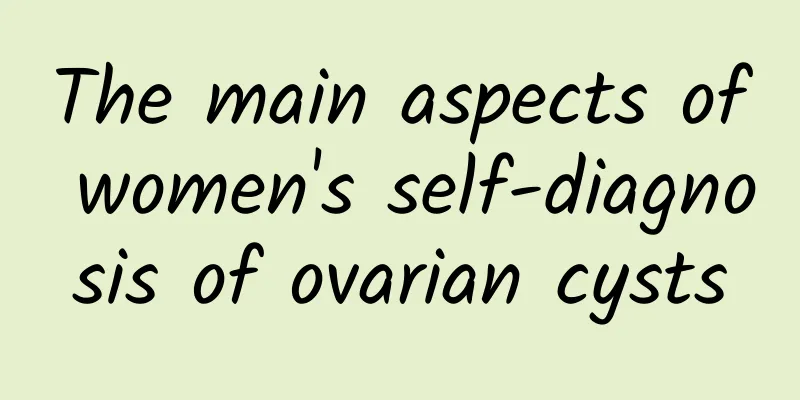The main aspects of women's self-diagnosis of ovarian cysts

|
What are the main aspects of self-diagnosis of ovarian cysts? We know that self-diagnosis of ovarian cysts is generally very easy, but most patients cannot make their own decisions because many of the symptoms are the same as other diseases. So what are the methods for self-diagnosis of ovarian cysts? The following is the expert's answer, I hope it will be helpful to you. 1. Discomfort in the lower abdomen. This is the initial symptom before the patient feels a mass in the lower abdomen. Due to the weight of the tumor itself and the influence of intestinal peristalsis and changes in body position, the tumor moves in the pelvic cavity, pulling on its pedicle and pelvic funnel ligament, causing the patient to feel distension and falling in the lower abdomen or iliac fossa; 2. Self-diagnosis of ovarian cysts can also be made through the thickening of abdominal circumference and the enlargement of abdominal mass. Patients feel that their clothes or belts are too tight and they just notice the enlargement of their abdomen, or they feel it by chance in the morning, so they press their abdomen and find that there is a mass in the abdomen, plus abdominal distension and discomfort. 3. Compression symptoms. Huge ovarian tumors can cause dyspnea and palpitations due to compression of the diaphragm. Ovarian tumors combined with large amounts of ascites can also cause such symptoms. However, some ovarian tumor patients have dyspnea due to unilateral or bilateral pleural effusion, including frequent urination without urinary pain or urgency, or constipation, which are all aspects of self-diagnosis of ovarian cysts. 4. Menstrual disorders. Generally, ovarian cysts, even bilateral ovarian cysts, do not cause menstrual disorders because they do not destroy all normal ovarian tissues. Some uterine bleeding is not endocrine, but may be caused by ovarian tumors that change the distribution of pelvic blood vessels, causing endometrial congestion; or by ovarian malignant tumors that directly metastasize to the endometrium. 5. Abdominal pain. If the tumor has no complications, there is little pain. Therefore, if patients with ovarian tumors feel abdominal pain, especially if it occurs suddenly, it is mostly caused by the twisting of the tumor pedicle, or occasionally by tumor rupture, bleeding or infection. In addition, malignant cysts often cause abdominal pain and leg pain, and the pain often causes patients to seek emergency treatment; I hope the answers from the experts above are helpful to you. If you can understand the above conditions well and make corresponding judgments, you can make your own diagnosis. However, if you still cannot master the self-diagnosis of ovarian cysts, it is recommended that you go to a professional hospital for corresponding examinations. I wish you a speedy recovery! Ovarian cysts http://www..com.cn/fuke/ncnn/ |
<<: What should I do if vaginitis keeps recurring?
>>: Expert introduction: Why ovarian cysts must be operated on
Recommend
5 natural foods to keep you slim and avoid gaining weight
You have tried hard to eat less and exercise more...
Gynecological experts tell you: Things to note before abortion surgery
What to do in case of unexpected pregnancy? Have ...
How much does it cost to treat Bartholinitis?
Bartholinitis is a serious disease that troubles ...
Some early symptoms of ectopic pregnancy
There are many symptoms of ectopic pregnancy. Onl...
What are the symptoms of spontaneous abortion infection?
Symptoms of spontaneous abortion infection includ...
What causes uterine fibroids? What are the factors that induce uterine fibroids?
Uterine fibroids, also known as uterine leiomyoma...
Causes of cervicitis
What causes cervicitis? Cervicitis is now a commo...
The calories from eating 4 glutinous rice balls during the winter solstice equals 1 bowl of rice! Nutritionist: Master these three tips to avoid eating fat and reduce the burden on your stomach and intestines
This Friday, December 22nd, is the Winter Solstic...
Supermodel goes crazy for "naked eating" to detoxify and lose weight! The mystery hidden in 48 degrees
Eating healthy is actually not difficult, especia...
What are the symptoms of chronic pelvic inflammatory disease?
Chronic pelvic inflammatory disease is a common d...
What are the symptoms of cervical warts?
Genital warts may be familiar to many people, but...
Why do women experience threatened miscarriage?
For women, ten months of pregnancy is very hard, ...
Three major causes of vulvar itching
Vulvar itching is actually caused by many disease...
What are the causes of irregular menstruation in women? Find the methods to regulate irregular menstruation here
Irregular menstruation may be caused by iron defi...
3 groups of people who are prone to cervical erosion What are the symptoms of cervical erosion
3 major groups of people who are prone to cervica...









